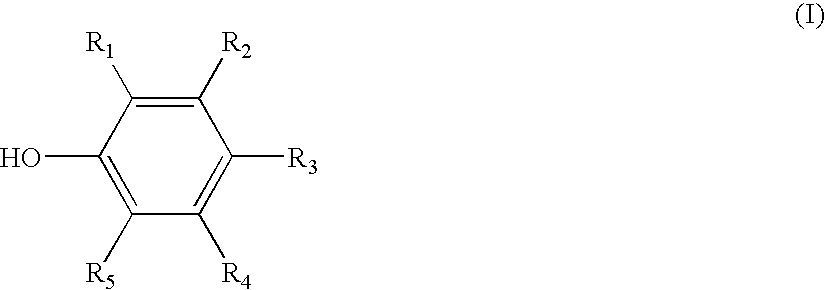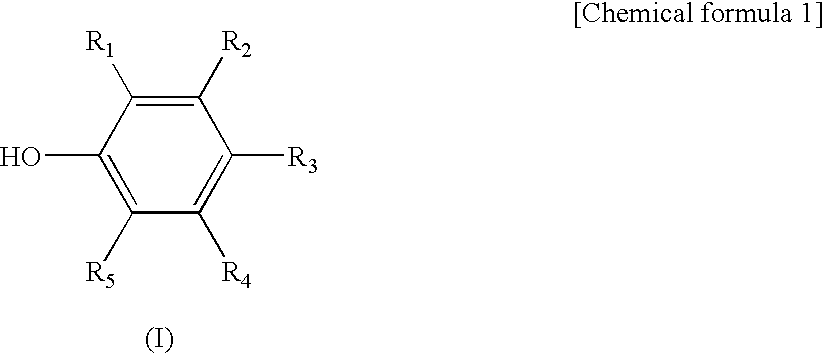Anti-microbial/anti-viral composition
a technology of composition and antiviral agent, applied in the field of antimicrobial and/or antiviral agent composition, can solve the problems of chemically synthesized pesticides still involving risks, adverse effects on humans, animals, environmental creatures, etc., and achieve the effects of reducing the use of chemical pesticides, effective inhibition, and excellent
- Summary
- Abstract
- Description
- Claims
- Application Information
AI Technical Summary
Benefits of technology
Problems solved by technology
Method used
Image
Examples
example 1
[0061] 10 mg of a laccase enzyme purified by the same method as described in JP-A-2001-522784 was dissolved in 10 cc of deionized water (0.1% by weight solution), and eugenol represented by the following structural formula (IV) and methyl syringate represented by the structural formula (V) were respectively mixed at a concentration of 0.01% by weight, to thereby prepare two kinds of anti-microbial / anti-viral compositions.
[0062] The resultant two kinds of compositions were impregnated in paper discs each having a diameter of 8 mm, and the paper discs were placed on a sucrose-potato agar plate medium innoculated with various plant pathogenic microorganisms, followed by culture at 25° C. After one week, the sizes of inhibition zones formed around the paper discs were determined. The results are shown in Table 1. Those results showed that both compositions had anti-microbial activities against various pathogenic microorganisms.
TABLE 1Size of inhibition zoneTest plant pathogenicLacca...
example 2
[0063] 24 g of potato dextrose was dissolved in 1 l of tap water to prepare a liquid medium, and 50 ml of the medium was poured in a Meyer flask having an inner volume of 250 ml. After the flask had been sealed with a silico plug, a sterilization treatment was performed at 121° C. for 20 minutes. Thereafter, the Meyer flask was cooled to room temperature, and one platinum loop of Schizophilum commune (IF06505) serving as a laccase-producing microorganism was inoculated. Subsequently, the culture medium was statically cultured at 28° C. for 14 days.
[0064] For the culture medium of the cultured Schizophilum commune (IF06505), hyphae were cut using a homogenizer, and water was added to adjust the concentration to 108 cfu / g formulation. Eugenol (0.01% by weight), calcium ligninsulfonate (3% by weight), and sodium lauryl sulfate (2% by weight) were added thereto, and mixed to prepare water-dispersible powder containing microbial cell-treated products.
[0065] For the thus-obtained water-...
example 3
[0068] Instead of the above-described water-dispersible powder containing a laccase-producing microorganism, 10 mg of the laccase enzyme purified by the same method as that described in JP-A-2001-522784 was dissolved in 10 cc of water at a concentration of 0.1% by weight. Then, eugenol, calcium ligninsulfonate, and sodium lauryl sulfate were added at concentrations of 0.01% by weight, 3% by weight, and 2% by weight, respectively, followed by mixing. The resultant water-dispersible powder was used to perform the same test as that of Example 2. The disease-preventing value was 75%.
PUM
| Property | Measurement | Unit |
|---|---|---|
| temperature | aaaaa | aaaaa |
| temperature | aaaaa | aaaaa |
| diameter | aaaaa | aaaaa |
Abstract
Description
Claims
Application Information
 Login to View More
Login to View More - R&D
- Intellectual Property
- Life Sciences
- Materials
- Tech Scout
- Unparalleled Data Quality
- Higher Quality Content
- 60% Fewer Hallucinations
Browse by: Latest US Patents, China's latest patents, Technical Efficacy Thesaurus, Application Domain, Technology Topic, Popular Technical Reports.
© 2025 PatSnap. All rights reserved.Legal|Privacy policy|Modern Slavery Act Transparency Statement|Sitemap|About US| Contact US: help@patsnap.com



